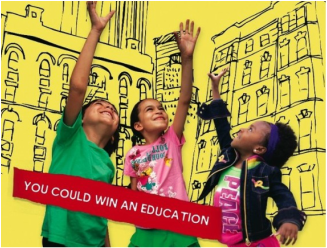 Who is to blame for students failing in school? Who is to blame for students failing in school? Tags: children/youth, class, education, inequality, ideology, individualism, meritocracy, sociological imagination, 00 to 05 mins, 61+ mins Year: 2010 Length: 1:37 (full film is 81:00) Access: YouTube Summary: This extra is from The Lottery, a documentary that examines the controversy around public schools, charters schools, and the educational reform movement. It follows the lives of four families in New York City who applied to the lottery to enter one of the best charter schools in the city. This short clip features person-on-the-street style interviews, where everyday people describe their views on why students don't succeed in schools (or watch the full film). Some of the responses include: "the only thing from stopping you from making it is your own self ... you can't blame the system. You blame yourself"; "the problems with our educational system are cultural"; "in one city you can have garbage schools up in our neighborhood, and then down there, amazing schools. and you can't tell me that's not race-based"; "if my school had been better, then I believe I wouldn't be on the streets." Viewers can be encouraged to consider which of the response reflect the sociological imagination, as compared with purely individualistic explanations. The clip could also be used to examine the role of ideology in American society. Individualistic explanations of schooling failures reflect the ideology of the American Dream, in which anyone can succeed if they work hard enough (and that the US functions as a meritocracy). This strong form of individualism serves to reinforce schooling inequalities by shifting the blame from structural forces (e.g. the distribution of school funding, class inequality) to individuals (children or their parents). This ideology obscures the reality, as shown in this Oprah clip and this mini-documentary, that dramatic inequalities in our public school system lead to different outcomes for students based on class, and often race. As the full film shows, thousands of students try to opt out of the failing public school system by entering the lottery, but only a small number will win the arbitrary process. On the other hand, wealthier families can purchase homes in better school districts or send their children to private schools; while winning the lottery is entirely by luck, the class system and educational funding are not. Submitted By: Paul Dean
2 Comments
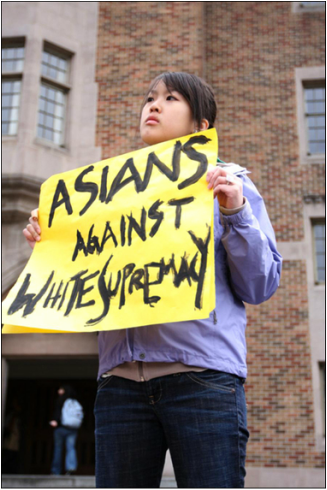 A student protests at the University of Washington (photo by Nick Feldman) A student protests at the University of Washington (photo by Nick Feldman)
Tags: economic sociology, education, inequality, methodology/statistics, organizations/occupations/work, prejudice/discrimination, race/ethnicity, aapi, asian american, income inequality, institutional discrimination, racism, white privilege, white supremacy, 00 to 05 mins
Year: 2014 Length: 2:43 Access: YouTube Summary: Here's an empirical fact that isn't acknowledged nearly enough: the United States is a white supremacist state. It has been a white supremacist state from the late 18th century right up to the present day, and while this conclusion may strike many as provacative or vulgar, it is not controversial among those who rely on empirical data to inform their views. To put it in different terms, there is a racial hierarchy in the U.S. and whites are at the top. White folks—myself included—receive the lion's share of power, privilege, and resources. Needless to say, whites are not inherently better or more deserving; nor have we received a disproportionate share of assets and resources because we have worked harder than People of Color. Our privileged position is because the institutions Americans navigate each day have been built to favor whites. Borrowing from writer John Scalzi's video game metaphor, whiteness affords those who have it the ability to play the game of life on the lowest difficulty setting. Metaphors are useful, but where is the evidence? In short, the evidence is everywhere. One need only look at patterns of housing discrimination, employment discrimination (and here), racial profiling (and here), incarceration, various health outcomes, poverty, wealth inequality, and income inequality, to name a few. But look once more at that last link on income inequality. Did you notice that in 2011 among full-time wage and salary workers in the United States, Asian Americans took home $872 on average compared to whites, who took home nearly $100 less? In a recent essay regarding Asian American discrimination, sociologist Tanya Maria Golash-Boza reported that by 2013 the pattern hadn't changed. Asians’ median weekly earnings were $973, as compared to $799 for whites. If Asians earn more, then why don't sociologists argue the U.S. is actually an Asian supremacist state? Or as the right-wing commentator Bill O'Reilly suggests in the above video, isn't it more accurate to talk about Asian privilege rather than white privilege? The video is useful for spurring discussion on this important topic, and I will conclude this post by suggesting a sociologically-informed "talking points" reply to O'Reilly. First, the average earnings statistic conceals the enormous variation found among different Asian subgroups. Given the disparity in earnings between Asians whose families immigrated from Southeast Asia and those from China, it is arguably misleading to lump these subgroups together. Second, education is a confounding variable, which is a shorthand way of saying that the income graph is misleading in yet another way. Asians look like they earn more than whites, but this is only because Asians have more education on average. The reason why Asians have higher average levels of education is a topic The Sociological Cinema has tackled elsewhere, but what O'Reilly's narrative of Asian privilege cannot explain away is the fact that when one compares whites and Asians who are in the same field, live in the same place, and have the same level of education, whites earn more (see Kim et al., 2010). Third, just as the election of Barack Obama did not suddenly end racism in the U.S., the determination of whether the United States is white supremacist does not hinge on a single measurement of well-being. Even if one makes the incredible leap of faith and believes Bill O'Reilly is competantly grasping the available data, it is important to remember that the labor market is but one dimension of human experience and only one place where racism has been measured. For instance, O'Reilly has not even begun to address cultural dimensions of white supremacy, such as white standards of beauty and masculinity. Submitted By: Lester Andrist 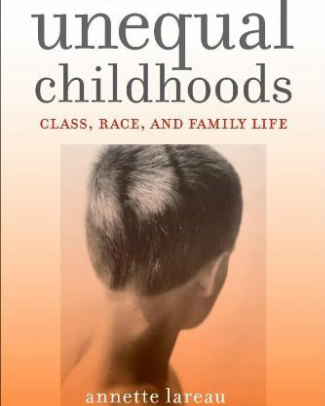 Kids' exposure to language can reproduce class inequality. Kids' exposure to language can reproduce class inequality. Tags: children/youth, class, culture, discourse/language, education, inequality, marriage/family, annette lareau, child-rearing, 00 to 05 mins, 06 to 10 mins Year: 2011, 2014 Length: 8:25; 0:57 Access: YouTube (8:25) New York Times (0:57) Summary: In her book, Unequal Childhoods, Annette Lareau describes how different child-rearing strategies in upper-middle class and poor/working-class homes reproduces class inequality. The way that parents use language with their children is one of several dimensions of family life that help to reproduce this class inequality (the variety of differences are illustrated in our previous post). Lareau found that in upper-middle class homes (through a process she calls concerted cultivation), children are exposed to wider vocabularies, taught to contest adult statements, use language in extended negotiations with parents, and learn through a combination of reasoning and directives. Comparatively, in working-class and poor homes (through the accomplishment of natural growth), children are exposed to fewer words, rarely question or challenge adults, learn more through directives, and generally accept the directives they are given. The first video supplements these findings in how language use varies across class. Todd Risling provides commentary on his study conducted with Betty Hart and published in their book, Meaningful Differences in the Everyday Experiences of Young American Children (1995). They recorded the number of words spoken to young children in welfare-supported homes, working-class homes, and white-collar professional homes. Their findings showed that, on average, children in professional homes were exposed to 1500+ more words per hour than children in welfare-supported homes. So after 1 year, this class difference led to an 8 million word gap, and by age 4, this produced a total gap of 32 million words. In addition to these variations in vocabulary and syntax, when exposed to more words, children were also more likely to hear more positive and affirmative statements, thus promoting better emotional outcomes. Furthermore, these levels of talking are strongly correlated with standard IQ scores. Their study provides quantitative support for class differences in vocabulary and emotional development, while Lareau's qualitative study shows the ways that children learn to use that language (which will later help them in professional contexts) and develop a sense of entitlement through these interactions with adults. Together, these differences help to provide middle-class children with advantages in educational and occupational settings. The second video briefly discusses a technology and strategy that can help address this inequality in language use. The child wears a small digital language processor that records interactions with the child, uploads the data to the cloud, and is then used to give feedback on how to incorporate language in everything the family does during the day. Viewers might be encouraged to consider other programs and strategies for addressing the language gap across social class. Submitted By: Paul Dean 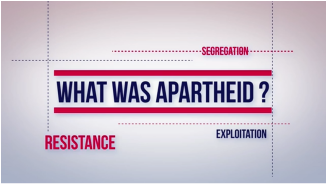 What was apartheid in South Africa? What was apartheid in South Africa? Tags: capitalism, education, immigration/citizenship, inequality, organizations/occupations/work, political economy, prejudice/discrimination, race/ethnicity, apartheid, racism, south africa, 00 to 05 mins Year: 2013 Length: 2:56 Access: YouTube Summary: In this short video from Al Jazeera's AJ+ web series, host Francesca Fiorentini provides a brief history of apartheid in South Africa. As Fiorentini explains, apartheid is an Afrikaans word that means separateness, but it came to represent a formal system of racial segregation that governed South Africa for nearly 50 years. People were classified by the categories "white," "black," "Indian," and a fourth category, "colored," which designated people of mixed race. Using this classification system, people were separated into different residential areas called homelands, which were typically rural, poor, and overcrowded. The movement of blacks outside of their homelands was tightly controlled through the pass laws. Under these laws, blacks had to carry permits at all times and obey strict curfews. Schools for blacks were underfunded, and in a system seemingly designed to funnel blacks into menial migrant labor, mandatory education for blacks ended at age 13. Lacking stable employment in economically deprived homelands, blacks were pushed to find work as migrant laborers. However, wages were low for such workers, and because it was illegal for them to strike, they had little recourse. As mentioned in this video, it is important not to lose sight of the political economy of apartheid. This system of separateness did not last for 50 years simply because of the deeply held prejudices of white South Africans; instead, apartheid was the edifice upon which South African companies could hang their profits. By upholding the apartheid system, powerful gold mining magnates could legally exploit black workers for deep profit with the consent of the state. Many Americans continue to read the story of apartheid in South Africa as a shameful and unrecognizable relic of ancient history, but the system was still in place as recently as 20 years ago. And while it was the law of the land for 50 years in South Africa, Jim Crow segregation prevailed in the United States for nearly 90 years. The truth is, apartheid is neither ancient nor unfamiliar to Americans. Note that another video on The Sociological Cinema explores the striking similarities between racial inequality in South Africa and the United States, and this Pinterest board explores the anti-apartheid movement. Submitted By: Lester Andrist 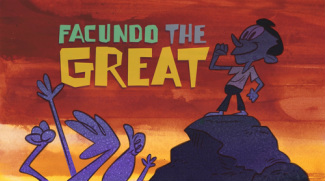 In second grade, Facundo's name was un-renameable. In second grade, Facundo's name was un-renameable. Tags: children/youth, discourse/language, education, immigration/citizenship, multiculturalism, race/ethnicity, hidden curriculum, identity, language politics, mexican-americans, subtitles/CC, 00 to 05 mins Year: 2012 Length: 1:51 Access: YouTube Summary: This video is one of several animated short videos that make up the larger StoryCorps oral history project, an archive of over 45,000 interviews with nearly 90,000 participants from across America telling their stories. The story recounted in this video is told by Ramón "Chunky" Sanchez. As described here, Chunky "was raised in a small farming community in southern California in the 1950s. As was common practice at that time, teachers at his local elementary school Anglicized the Mexican American students' names." The anglicisation of personal names is the practice by which non-English-language personal names are either changed so that their spellings are closer to English sounds or English personal names are substituted for non-English names. This practice can be a personal choice or it can be imposed upon people by (more powerful) others, such as immigration officials or, in the case of Chunky's story, school administrators. While sociologists and others have documented the ways in which immigrant groups have strategically chosen to adopt or reject "American-sounding names," Chunky's story is one in which he and his classmates were subject to this practice without choice. Children with "Mexican-sounding" names had their names anglicized. For example, as Chunky explains, Maria became Mary and Juanita became Jane. Chunky's own name, Ramón, was changed to Raymond. Yet, Chunky recounts a time in second grade when his teachers had a difficulty renaming the new kid in class, Facundo. After watching the video, viewers might consider some of the following questions: (1) Why did teachers anglicize the names of students in Chunky's class? What messages did this renaming send to the students? (2) In Chunky's story, why is Facundo celebrated as a hero, and his non-renaming a victory? Each StoryCorps conversation is preserved at the American Folklife Center at the Library of Congress, and weekly StoryCorps segments are broadcasted on NPR’s Morning Edition. For more on Chunky Sanchez and the making of this short animation, click here. Submitted By: Anonymous 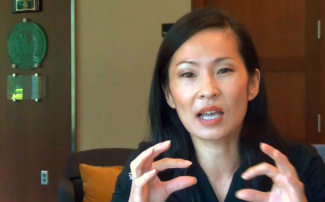 SooJin Pate explains microaggressions SooJin Pate explains microaggressions Tags: discourse/language, education, immigration/citizenship, inequality, nationalism, prejudice/discrimination, race/ethnicity, social mvmts/social change/resistance, theory, microaggressions, subtitles/CC, 00 to 05 mins Year: 2013 Length: 5:06 Access: YouTube Summary: Microaggressions are something that happens every day, but which not many people really understand. This is a five-minute video about microaggressions featuring Professor SooJin Pate, who received her Ph.D. in American Studies at the University of Minnesota. In the video, she explains microaggressions with a couple of every day examples along with a personal anecdote, and then goes on to give advice for interrupting microaggressions. This is a great piece for helping students understand microaggressions and contextualize how they can interrupt them both as a microaggressor and a victim of microaggressions. Many students find SooJin Pate's radical approaches of kindness and activism to be an empowering way of understanding their role in achieving social justice. It is great both as an introduction to microaggressions, for students just becoming familiar with the topic; and also for students already familiar with concepts like Critical Race Theory and the Pedagogy of the Oppressed, as another perspective on the interruption of discrimination in their daily lives. Note that The Sociological Cinema has also explored the concept of microaggressions in an earlier post. Submitted By: Macalester College Department of Multicultural Life 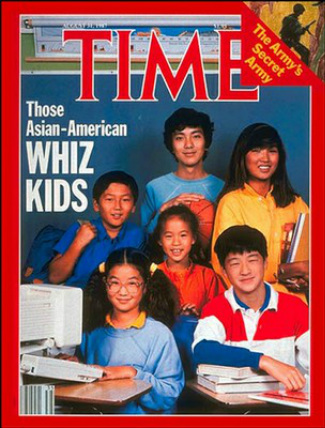 The model minority stereotype hurts Asian-Americans. The model minority stereotype hurts Asian-Americans. Tags: biology, culture, education, immigration/citizenship, race/ethnicity, asian-americans, model minority, stereotype, 00 to 05 mins Year: 2007 Length: 5:40 Access: YouTube Summary: Because Asian-Americans are often better off educationally and economically than whites and other minorities, many people believe in the racial stereotype that Asian-Americans are the model minority. This stereotype argues that Asians are naturally smarter or always fare better because of their strong “family values” and work ethic, with some arguing they are a “superminority” and have been “outwhiting the whites.” This CNN news clips analyzes and critiques the model minority stereotype. The video accurately notes there are no biological or genetic differences between Asians and any other so-called race (see video on race as a social construction). It cites psychological research from Hazel Markus (featured in the video) documenting how racial/cultural identity does shape some Asian-Americans' educational performance. The video further adds that the Asian-American classification is comprised of individuals from more than 12 countries, and that not all Asian immigrants or Asian-Americans performed equally well in education or economic success (a distinction that the stereotype ignores). However, the video fails to note the recent changes in Asian immigration that also affect educational and economic differences between Asians, whites, and other racial minorities. Specifically, many early Asian immigrants came to the US with relatively higher levels of education, English language skills, and occupational skills. More recent Asian immigrants tend to have less educational and economic resources, which again, is overlooked by the racial stereotype. Viewers are encouraged to consider: how does this seemingly positive racial stereotype actually hurt Asians (and other minorities)? As noted in this video interview with an Asian-American advocate, the stereotype prevents resources from being directed into the Asian-American community because "people are not aware of the critical needs" that exist. It also hurts other racial minorities (e.g., African-Americans) because the stereotype gets used to legitimate the opportunities of racial minorities in the US and to argue against the need for resources distributed to those communities. Submitted By: Paul Dean  Tags: culture, education, science/technology, social mvmts/social change/resistance, cultural lag, material culture, nonmaterial culture, popular culture, social change, symbolic culture, 00 to 05 mins Year: 1993 Length: 3:32 Access: YouTube Summary: In 1993 and 1994, AT&T released a series of commercials depicting a host of cutting edge technologies. In one commercial a man relaxes on a beach holding what appears to be a tablet computer: "Have you ever sent a fax from the beach?" comes the voiceover. "You will." This ad campaign might be useful for instructors seeking to illustrate the distinction between two aspects of any culture: material and nonmaterial. Nonmaterial culture refers to things like values, norms, and social roles, while material culture refers to the physical artifacts of a culture and typically includes the sorts of things people can touch. When a person asserts that hamburgers are a part of American culture, they are really referring to material culture. Tablets and cell phones too are manifestations of material culture. Most of the twenty or so innovative products depicted in AT&T's "You will" ad campaign have long since faded into the vast tableau of consumers' technologically augmented lives, but with the benefit of hindsight, it's possible to draw on the commercials to reflect on how technology has changed the lives of average people. To put it differently, how do changes in material culture give rise to changes in nonmaterial culture? For instance, to the extent that technological advances are driving the growth of massive open online courses (MOOCs), what kinds of changes in the nonmaterial aspects of higher education will likely follow suit? How are the norms, values, and roles usually associated with educational institutions being permanently altered? Finally, while it may seem apparent that technological changes in material culture drive changes in nonmaterial culture, is the reverse ever true? Do changes in norms, values, and roles give rise to changes in technology? Submitted By: Steven Dashiell  Tags: education, inequality, knowledge, race/ethnicity, meritocracy, standardized testing, 21 to 60 mins Year: 1999 Length: 60:00 Access: no online access; transcript Summary: This PBS Frontline documentary is an excellent compliment to any classroom discussion on the sociology of education, inequality, and presumed notions of American meritocracy; specifically, the film would pair well with Mickelson and Smith's article, "Can Education Eliminate Race, Class, and Gender Inequality?" The film's website provides the following synopsis: "Just days before hundreds of thousands of high school students take the SAT--a three-hour college entrance exam that tests verbal and math skills--FRONTLINE's Secrets of the SAT examines the national obsession over the SAT and the controversy over its fairness, reliability and impact on racial diversity on campus. This report draws on the work of Nicholas Lemann and his five-year study of the SAT--The Big Test: The Secret History of the American Meritocacy. Lemann discusses the origins of the SAT, the idea of an American meritocracy (an idea that goes back to correspondance between Thomas Jefferson and John Adams), and how the SAT today has become a ticket into America's ruling class. To discover just how important SAT scores are to a student's future, FRONTLINE looks at the booming test prep business which offers test preparation courses for students as young as 13 and 14. FRONTLINE's cameras also follow seven students who are applying to the University of California, Berkeley, the country's most selective public university, and go inside the admissions process at Berkeley where those seven students are competing with 31,000 others for 3,500 spots. Berkeley's director of admissions, Bob Laird, explains how Berkeley is shifting away from test numbers and towards a more rounded evaluation of applicants. However, since California's Proposition 209 was passed in 1996, the university cannot consider race in the admissions process. Consequently, the numbers of minority students who get into Berkeley has dropped sharply because black and Hispanic students test scores are 100-200 points lower than whites and Asians. How then can Berkeley encourage diversity on its campus without violating the law? FRONTLINE explores the debate over race sensitive admission policies in interviews with Derek Bok and William Bowen, former presidents, respectively, of Harvard and Princeton University, who conducted a 30-year study of race sensitive admission policies which shows their positive effect. FRONTLINE also interviews educators John Yoo and Abigail Thernstrom who argue for race neutral admissions. Secrets of the SAT also takes a closer look at the black-white test score gap which though large, eludes easy explanation. Psychology professor Claude Steele at Stanford University explains how his research may partly explain the disparity. His studies focused on the way good students do poorly on tests because they suffer from negative stereotypes about their abilities. And then there is the issue of what exactly does the SAT measure and, does it correlate with I.Q.? Test prep experts John Katzman, founder of Princeton Review and Jonathan Grayer, head of Kaplan Educational Centers, as well as law professor Lani Guinier, analyze and debate the reliability of standardized tests like the SAT and their predictive ability for success later in life. And Robert Sternberg, a researcher on human intelligence, argues for broadening the definition of intelligence and creating new tools to measure it. This report ends with news on which of the seven students FRONTLINE followed won admission to Berkeley. Did some of these students' low SAT scores affect Berkeley's decision to admit them or not?" The film's website provides additional resources, including a teacher's guide and information for how to purchase the film. You can also see if the film is available at your local or university library. I would like to thank Dr. Linda Moghadam for suggesting this video. Submitted By: Valerie Chepp  Tags: crime/law/deviance, education, gender, inequality, organizations/occupations/work, comedy, sexual harassment, workplace ethics, 00 to 05 mins Year: 2009 Length: 4:42 Access: YouTube Summary: This comedy skit from Madtv depicts a group of employees receiving a lesson around sexual harassment awareness. When one employee does not understand the concept of what sexual harassment entails, he articulates several commonplace statements frequently used to justify or diminish the seriousness of sexual harassment in the workplace. Such statements include notions around women not knowing "how to take a compliment" and "over-reacting" (or, as he says, "flying off the handle"). He also suggests that men are simply trying to "boost women's spirits" through compliments or that sometimes men "accidentally" touch women inappropriately. The workshop facilitator, increasingly frustrated, highlights the ways in which sexual harassment, though sometimes difficult to articulate through words (and, by extension, rules and policies), can come into sharper focus when experienced firsthand. In addition to illustrating basic concepts around what sexual harassment entails, this clip offers a nice launching pad for a discussion of what sexual harassment feels like (and why this feeling or interactional dynamic might be challenging to sufficiently codify into rules and policies). Submitted By: J. Deluna, L. Teniente, R. Nuñez |
Tags
All
.
Got any videos?
Are you finding useful videos for your classes? Do you have good videos you use in your own classes? Please consider submitting your videos here and helping us build our database!
|
 RSS Feed
RSS Feed
